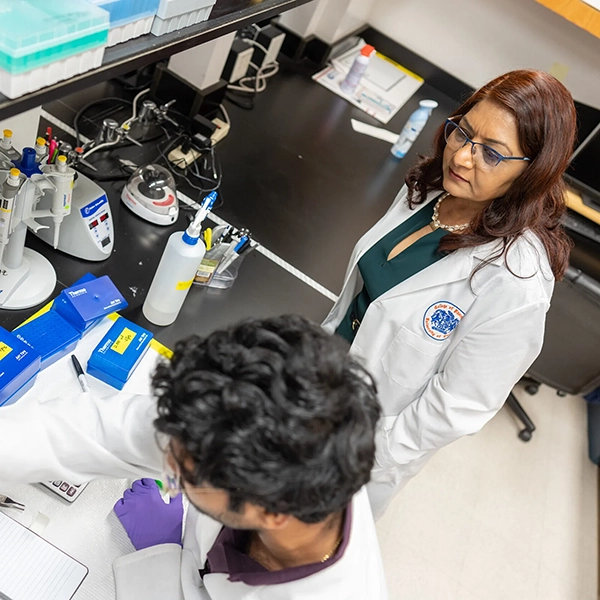

Research Terms
Leukemia Pharmacology Clinical Pharmacology
Keywords
Cancer Epigenomics Leukemia Metabolomics Pharmacogenetics Pharmacogenomics
Industries
This antibody-based therapy targets blood cancer cells expressing CD33 protein variants that the current immunotherapy fails to recognize. The expression of the protein CD33 is a marker of cancerous white blood cells, making it an excellent target for immunotherapy in acute myeloid leukemia (AML) patients. Each year, there are approximately 20,000 new diagnoses of AML in the United States. The current standard treatment for CD33-positive AML is gemtuzumab ozogamicin. However, the therapy is ineffective in patients expressing a variant T allele, leading to the expression of CD33 variants, CD33 full length (CD33FL) and CD33D2, a CD33 variant lacking the IgV domain. Consequently, patients expressing the CD33D2 variant can't benefit from conventional anti-CD33 immunotherapy.
Researchers at the University of Florida have developed antibodies binding to the IgC-like domain, present in full-length CD33 (CD33FL) and shortened CD33D2. Recognizing and binding to a domain shared between both isoforms can benefit AML patients expressing CD33D2.
Recognizes and targets CD33 isoforms to treat acute myeloid leukemia (AML) and other patients with malignancies
The CD33 antigen is present on the surface of acute myeloid leukemia (AML) cells, making it an excellent marker and target for AML immunotherapy. Conventional AML immunotherapies target the IgV domain coded by exon 2 of CD33 gene. However, some patients present a genetic variation in the splice enhancer region within exon 2 of CD33 gene, resulting in an alternative spliced CD33 isoform lacking IgV domain (CD33D2). Therefore, patients expressing this isoform do not show any clinical benefit from the traditional immunotherapy These antibodies bind CD33 on its constant domain (IgC), found in both CD33FL and CD33D2 isoforms. By enabling the targeting of both CD33 variants, it can provide treatment to a sizeable range of AML patients.
This pLSC6 predictive scoring system identifies relapse risk and treatment outcomes in acute myeloid leukemia (AML) patients based on the expression levels of six genes. The persistence of leukemic stem cells (LSC) is the primary cause of acute myeloid leukemia (AML) relapse and drug resistance, the most prevalent forms of treatment failure for both pediatric and adult patients. The standard induction treatment of AML patients involves ara-C (Cytarabine) and daunorubicin and etoposide (ADE standard chemotherapy). Current prognostic tests use a 17-gene panel, highlighting the need for one with increased predictive power, identifying patients at risk for relapse or potential candidates for transplantation.
Researchers at the University of Florida have developed a pLSC6 predictive scoring system for acute myeloid leukemia (AML) based on a six-gene panel. The panel identifies high- or low-risk patients, those who could benefit from transplants or have a potential for disease relapse.
Predicts relapse risk and treatment outcomes in acute myeloid leukemia (AML) patients, aiding in the development of treatment plans
This pLSC6 predictive scoring system uses the gene expression levels of six genes from leukemic cells extracted from patients at diagnosis. RNA transcripts, a set of genes comprising DNMT3B, GPR56, CD34, SOCS2, SPINK2, and FAM30A, and at least one reference gene, are transcribed to produce a set of cDNAs. The amplification products of the cDNAs are quantified to obtain the levels of amplification products in the biological sample, calculating the pLSC6 score and comprising a report. The score aids in determining a prognosis of a cancer patient, such as event-free survival (EFS), overall survival (OS), predicting relapse and treatment outcomes, or assessing whether a patient is a candidate for transplantation therapy.
















































